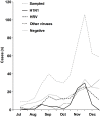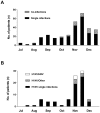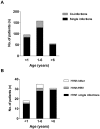Respiratory viruses in hospitalized children with influenza-like illness during the h1n1 2009 pandemic in Sweden [corrected]
- PMID: 23272110
- PMCID: PMC3522717
- DOI: 10.1371/journal.pone.0051491
Respiratory viruses in hospitalized children with influenza-like illness during the h1n1 2009 pandemic in Sweden [corrected]
Erratum in
- PLoS One. 2013;8(7). doi:10.1371/annotation/fcd5bca6-cbc4-493e-9083-d11903bcbc48
Abstract
Background: The swine-origin influenza A(H1N1)pdm09 pandemic of 2009 had a slower spread in Europe than expected. The human rhinovirus (HRV) has been suggested to have delayed the pandemic through viral interference. The importance of co-infections over time during the pandemic and in terms of severity of the disease needs to be assessed.
Objective: The aim of this study was to investigate respiratory viruses and specifically the presence of co-infections with influenza A(H1N1)pdm09 (H1N1) in hospitalized children during the H1N1 pandemic. A secondary aim was to investigate if co-infections were associated with severity of disease.
Methods: A retrospective study was performed on 502 children with influenza-like illness admitted to inpatient care at a pediatric hospital in Stockholm, Sweden during the 6 months spanning the H1N1 pandemic in 2009. Respiratory samples were analyzed for a panel of 16 viruses by real-time polymerase chain reaction.
Results: One or more viruses were detected in 61.6% of the samples. Of these, 85.4% were single infections and 14.6% co-infections (2-4 viruses). The number of co-infections increased throughout the study period. H1N1 was found in 83 (16.5%) children and of these 12 (14.5%) were co-infections. HRV and H1N1 circulated to a large extent at the same time and 6.0% of the H1N1-positive children were also positive for HRV. There was no correlation between co-infections and severity of disease in children with H1N1.
Conclusions: Viral co-infections were relatively common in H1N1 infected hospitalized children and need to be considered when estimating morbidity attributed to H1N1. Population-based longitudinal studies with repeated sampling are needed to improve the understanding of the importance of co-infections and viral interference.
Conflict of interest statement
Figures



Similar articles
-
The 2009 pandemic influenza A(H1N1) coincides with changes in the epidemiology of other viral pathogens causing acute respiratory tract infections in children.Infection. 2014 Apr;42(2):303-8. doi: 10.1007/s15010-013-0545-5. Epub 2013 Oct 23. Infection. 2014. PMID: 24150959 Free PMC article.
-
Respiratory virus infections among hospitalized patients with suspected influenza A H1N1 2009 virus during the first pandemic wave in Brazil.Braz J Infect Dis. 2011 May-Jun;15(3):220-4. doi: 10.1016/s1413-8670(11)70179-9. Braz J Infect Dis. 2011. PMID: 21670921
-
Viral respiratory infections during the 2009 influenza A(H1N1) outbreak in the West Midlands Region, UK.Epidemiol Infect. 2012 Sep;140(9):1551-6. doi: 10.1017/S0950268811002251. Epub 2011 Nov 11. Epidemiol Infect. 2012. PMID: 22074791
-
Circulation of other respiratory viruses and viral co-infection during the 2009 pandemic influenza.Enferm Infecc Microbiol Clin. 2012 Oct;30 Suppl 4:25-31. doi: 10.1016/S0213-005X(12)70101-5. Enferm Infecc Microbiol Clin. 2012. PMID: 23116789 Free PMC article. Review.
-
The role of pneumonia and secondary bacterial infection in fatal and serious outcomes of pandemic influenza a(H1N1)pdm09.BMC Infect Dis. 2018 Dec 7;18(1):637. doi: 10.1186/s12879-018-3548-0. BMC Infect Dis. 2018. PMID: 30526505 Free PMC article. Review.
Cited by
-
Etiology of Clinical Community-Acquired Pneumonia in Swedish Children Aged 1-59 Months with High Pneumococcal Vaccine Coverage-The TREND Study.Vaccines (Basel). 2021 Apr 14;9(4):384. doi: 10.3390/vaccines9040384. Vaccines (Basel). 2021. PMID: 33919904 Free PMC article.
-
Respiratory viral coinfection and disease severity in children: A systematic review and meta-analysis.J Clin Virol. 2016 Jul;80:45-56. doi: 10.1016/j.jcv.2016.04.019. Epub 2016 Apr 30. J Clin Virol. 2016. PMID: 27155055 Free PMC article.
-
Differences in clinical severity of respiratory viral infections in hospitalized children.Sci Rep. 2021 Mar 4;11(1):5163. doi: 10.1038/s41598-021-84423-2. Sci Rep. 2021. PMID: 33664311 Free PMC article.
-
Assessment of Virus Interference in a Test-negative Study of Influenza Vaccine Effectiveness.Epidemiology. 2017 Jul;28(4):514-524. doi: 10.1097/EDE.0000000000000670. Epidemiology. 2017. PMID: 28362642 Free PMC article.
-
Influenza interaction with cocirculating pathogens and its impact on surveillance, pathogenesis, and epidemic profile: A key role for mathematical modelling.PLoS Pathog. 2018 Feb 15;14(2):e1006770. doi: 10.1371/journal.ppat.1006770. eCollection 2018 Feb. PLoS Pathog. 2018. PMID: 29447284 Free PMC article. Review.
References
-
- Dawood FS, Jain S, Finelli L, Shaw MW, Lindstrom, et al (2011) Emergence of a Novel Swine-Origin Influenza A (H1N1) Virus in Humans. N Eng J Med 360: 2605–2615. - PubMed
-
- Falagas ME, Cholevas NV, Kapaskelis AM, Vouloumanou EK, Michalopoulos A, et al. (2010) Epidemiological aspects of 2009 H1N1 influenza: the accumulating experience from the Northern Hemisphere. Eur J Microbiol Infect Dis 29: 1327–1347. - PubMed
-
- Swedish Institute for Communicable Disease Control (2010) Influensarapport vecka 1 (4/1–10/1). [article in swedish] http://smi.se/publikationer/veckorapporter/influensarapporter/sasongen20.... [cited 7 june 2012].
MeSH terms
LinkOut - more resources
Full Text Sources
Medical

